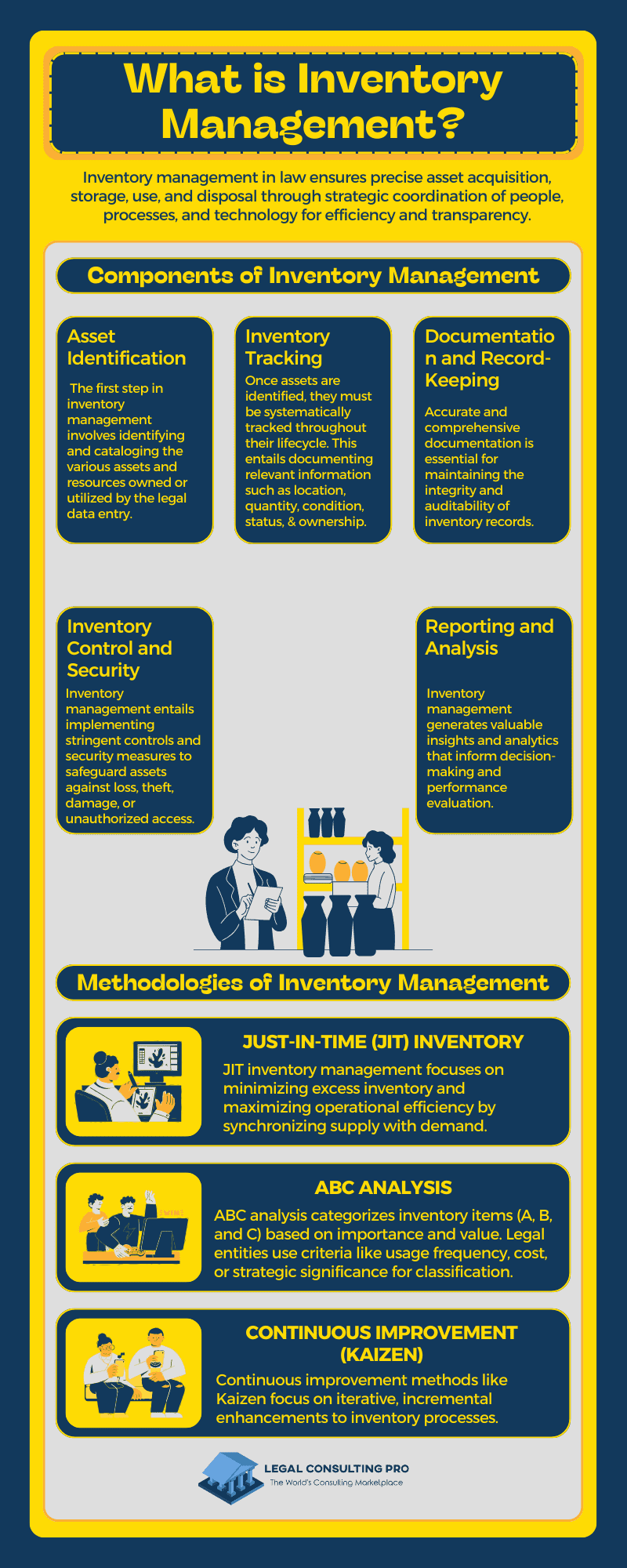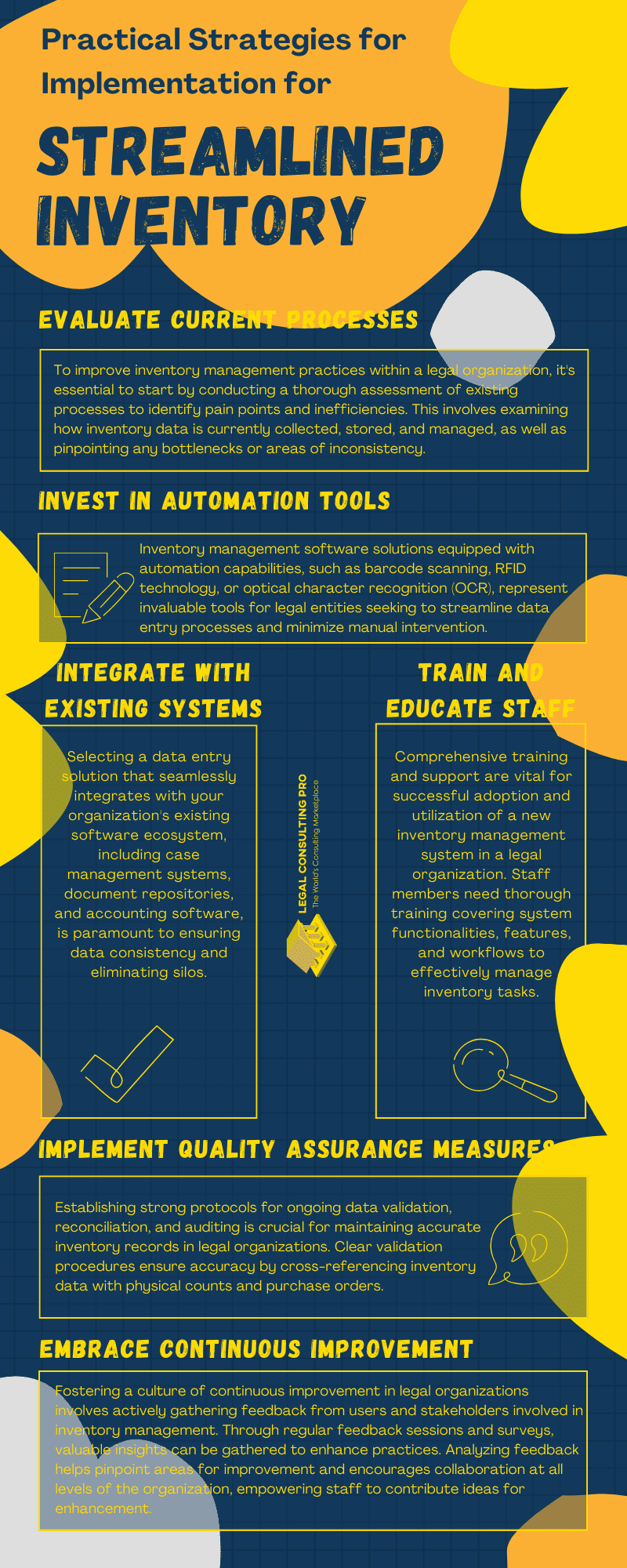In the realm of legal data entry operations, maintaining accurate and up-to-date inventory records is paramount. Law firms, corporate legal departments, and litigation support services rely heavily on meticulous inventory management to track assets, evidence, and documents critical to legal data entry proceedings. However, the traditional methods of inventory management are often cumbersome and prone to errors, leading to inefficiencies and potential legal setbacks.
In this article, we delve into the importance of streamlined inventory legal data entry and how it revolutionizes asset management within the legal industry. We’ll explore the challenges associated with conventional inventory practices, the benefits of adopting streamlined data entry solutions, and practical strategies for implementation.
What is Inventory Management?
Inventory management refers to the disciplined process of overseeing and controlling the acquisition, storage, utilization, and disposal of assets and resources within a legal organization. It involves the strategic coordination of people, processes, and technologies to ensure that inventory-related activities are conducted with precision, transparency, and efficiency.
Components of Inventory Management
- Asset Identification: The first step in inventory management involves identifying and cataloging the various assets and resources owned or utilized by the legal data entry. This includes physical assets such as documents, files, exhibits, and equipment, as well as digital assets such as electronic records, databases, and software licenses.
- Inventory Tracking: Once assets are identified, they must be systematically tracked throughout their lifecycle. This entails documenting relevant information such as location, quantity, condition, status, and ownership. Advanced tracking mechanisms such as barcoding, RFID tagging, or GPS tracking may be employed to facilitate real-time visibility and monitoring.
- Documentation and Record-Keeping: Accurate and comprehensive documentation is essential for maintaining the integrity and auditability of inventory records. Legal entities must establish robust record-keeping practices to capture pertinent details related to asset transactions, movements, and usage. This documentation serves as a historical trail that supports accountability, compliance, and legal data entry defensibility.
- Inventory Control and Security: Inventory management entails implementing stringent controls and security measures to safeguard assets against loss, theft, damage, or unauthorized access. Physical security protocols, access controls, encryption, and data privacy safeguards are essential components of a robust inventory management framework.
- Reporting and Analysis: Inventory management generates valuable insights and analytics that inform decision-making and performance evaluation. Legal data entry leverages reporting tools and dashboards to monitor inventory metrics, analyze trends, and identify opportunities for optimization. By leveraging data-driven insights, organizations can enhance efficiency, mitigate risks, and allocate resources strategically.
Methodologies of Inventory Management
- Just-In-Time (JIT) Inventory: JIT inventory management focuses on minimizing excess inventory and maximizing operational efficiency by synchronizing supply with demand. Legal entities adopt JIT principles to reduce storage costs, minimize waste, and improve responsiveness to client needs.
- ABC Analysis: ABC analysis categorizes inventory items based on their relative importance and value to the organization. Legal entities classify assets (A, B, and C) based on criteria such as usage frequency, cost, or strategic significance. This classification enables prioritization, resource allocation, and risk mitigation strategies.
- Continuous Improvement (Kaizen): Continuous improvement methodologies such as Kaizen emphasize iterative, incremental enhancements to inventory management processes. Legal entities foster a culture of continuous improvement by empowering employees to identify inefficiencies, implement corrective actions, and drive operational excellence.
The Importance of Inventory Management
Inventory management is not merely a logistical task; it is a strategic imperative for legal data entry for several compelling reasons:
- Asset Tracking and Accountability: Legal proceedings often involve a myriad of physical and digital assets, including documents, evidence, exhibits, and equipment. Effective inventory management ensures that these assets are meticulously tracked, safeguarded, and accounted for throughout their lifecycle. This level of accountability is essential for maintaining the integrity of legal data entry proceedings and complying with regulatory requirements.
- Evidence Preservation and Chain of Custody: In litigation and dispute resolution scenarios, maintaining an unbroken chain of custody for evidence is paramount. Proper inventory management facilitates the documentation of when, where, and by whom each piece of evidence was collected, stored, and accessed. This not only preserves the integrity of evidence but also withstands scrutiny in court, bolstering the credibility of legal arguments.
- Resource Optimization and Cost Efficiency: Legal data entry operates within finite resource constraints, including time, budget, and personnel. Effective inventory management enables organizations to optimize resource allocation by identifying underutilized assets, minimizing redundancies, and avoiding unnecessary expenditures. By streamlining workflows and reducing waste, legal teams can enhance operational efficiency and achieve cost savings.
- Compliance and Risk Mitigation: The legal data entry landscape is replete with regulatory requirements, industry standards, and ethical obligations that govern the handling of sensitive information and materials. Robust inventory management practices ensure compliance with data protection laws, confidentiality agreements, and other regulatory mandates. By mitigating the risk of non-compliance, legal entities safeguard their reputation, minimize legal data entry exposure, and avoid potential sanctions or penalties.
- Strategic Decision-Making and Performance Measurement: Accurate and timely inventory data empowers litigation support services providers to make informed decisions and strategic choices. By analyzing trends, patterns, and metrics related to asset utilization, case management, and resource allocation, organizations can optimize their strategic priorities, allocate resources effectively, and drive better outcomes. Additionally, inventory management facilitates performance measurement and benchmarking, enabling organizations to track their progress, identify areas for improvement, and demonstrate value to stakeholders.

The Challenges of Conventional Inventory Management
Conventional inventory management in legal data entry settings typically involves manual data entry, spreadsheets, or outdated software systems. While these methods may have sufficed in the past, they pose several challenges in today’s fast-paced legal landscape:
Human Error
Manual data entry, while once a primary method for recording inventory in legal settings, is now recognized as inherently susceptible to various errors and inefficiencies. Here’s an in-depth elaboration on why manual data entry poses risks and how these risks can impact the integrity of legal data entry proceedings:
- Typos: One of the most common errors in manual data entry is typos – unintentional mistakes in typing or handwriting. These errors can occur due to factors such as fatigue, distractions, or lack of attention to detail. For example, a legal professional might inadvertently transpose digits or letters when recording asset serial numbers or document identifiers. Even minor typos can result in significant discrepancies in inventory records, leading to confusion, delays, or misallocation of resources.
- Misinterpretations: Manual data entry also leaves room for misinterpretations, particularly when dealing with handwritten notes or unclear instructions. Human interpretation is subjective and can vary based on factors such as individual perception, context, or language proficiency. As a result, what one person interprets as a specific inventory item or attribute may differ from another’s interpretation. These discrepancies can compound over time, leading to inconsistencies and inaccuracies in inventory records.
Time-Consuming
Manually inputting data into spreadsheets or legacy software systems represents a labor-intensive process that imposes significant burdens on litigation support services providers and their organizations. Here’s a detailed elaboration on why manual data entry is time-consuming and resource-intensive, and how it detracts from more strategic tasks:
- Time-Consumption: Manual data entry requires litigation support services providers to dedicate substantial time and effort to inputting, validating, and updating inventory records manually. This process is often repetitive and monotonous, involving tasks such as typing, copying, and pasting data from various sources into spreadsheet cells or software fields. As a result, legal staff may spend hours each day performing data entry tasks, diverting valuable time away from more meaningful and high-impact activities.
- Repetitive Nature: The repetitive nature of manual data entry exacerbates its time-consuming nature. Litigation support services providers may find themselves engaged in mind-numbing tasks that offer little intellectual stimulation or professional development opportunities. Moreover, the risk of fatigue and boredom associated with repetitive data entry tasks can lead to decreased productivity, increased errors, and diminished job satisfaction among employees.
- Error-Prone: Manual data entry is inherently prone to errors, as discussed earlier. Litigation support services providers must meticulously review and cross-reference data to ensure accuracy, a process that further prolongs the time required for data entry. Moreover, the risk of errors increases with the volume and complexity of the data being entered, such as lengthy document lists, detailed asset inventories, or intricate metadata requirements. As a result, legal staff may find themselves caught in a cycle of data entry and error correction, further compounding the time investment required.
Lack of Accessibility
Traditional inventory systems, characterized by manual record-keeping and fragmented data storage, often fall short in providing real-time visibility and accessibility to legal teams, particularly in multi-location settings. Here’s an in-depth elaboration on why traditional inventory systems struggle to meet the needs of modern legal data entry operations:
- Manual Record-Keeping: Traditional inventory systems rely on manual record-keeping methods such as paper-based logs, spreadsheets, or disparate databases. This manual approach to inventory management lacks the automation and integration capabilities necessary to provide real-time visibility into asset movements, transactions, and statuses. As a result, legal teams must rely on outdated or incomplete information, leading to delays, errors, and inefficiencies.
- Fragmented Data Storage: In traditional inventory systems, data is often stored in fragmented or siloed repositories, making it challenging for legal teams to access and retrieve information quickly and efficiently. For example, inventory records may be stored in separate spreadsheets, file cabinets, or software systems across different departments or locations. This fragmentation hampers data visibility and accessibility, as litigation support services providers must navigate multiple systems or sources to obtain the information they need.
Compliance Risks
Inaccurate inventory records pose significant risks and consequences for legal data entry, ranging from compliance violations to legal disputes. Here’s an in-depth elaboration on how inaccurate inventory records can lead to compliance violations, regulatory penalties, and legal data entry disputes:
- Compliance Violations: Legal entities are often subject to regulatory requirements, industry standards, and internal policies governing the management and documentation of inventory. Inaccurate inventory records can lead to non-compliance with these regulations, exposing the organization to legal data entry and financial risks. For example, failing to maintain accurate records of controlled substances or confidential client information may result in violations of regulatory frameworks such as HIPAA (Health Insurance Portability and Accountability Act) or GDPR (General Data Protection Regulation).
- Regulatory Penalties: Regulatory agencies have the authority to impose penalties and sanctions on organizations that fail to comply with inventory management requirements. Inaccurate inventory records may trigger regulatory audits or investigations, leading to fines, penalties, or even license revocations. For example, financial institutions may face penalties from regulatory authorities such as the SEC (Securities and Exchange Commission) or FINRA (Financial Industry Regulatory Authority) for inaccuracies in reporting financial assets or transactions.
- Legal Disputes: Inaccurate inventory records can give rise to legal data entry disputes between parties involved in commercial transactions, contractual agreements, or litigation proceedings. Discrepancies in inventory documentation may lead to allegations of fraud, breach of contract, or negligence, resulting in costly litigation and damage to the organization’s reputation. For example, a supplier may sue a legal entity for non-payment or breach of contract if discrepancies in inventory records indicate that goods were not received or accounted for as per the agreement.
The Benefits of Streamlined Inventory Legal Data Entry
Streamlined inventory legal data entry offers a modern solution to the challenges posed by conventional methods. By leveraging advanced technologies such as automation, cloud computing, and integrated software platforms, litigation support services providers can unlock numerous benefits:
Accuracy and Consistency
Automated data entry tools represent a transformative solution for legal entities seeking to mitigate the risks associated with human error in inventory management. These tools leverage advanced technologies such as optical character recognition (OCR), data extraction algorithms, and machine learning to streamline data entry processes and enhance accuracy. By automating data entry tasks, legal teams can reduce the likelihood of errors and ensure that inventory records are accurate and consistent.
One of the primary advantages of automated data entry tools is their ability to eliminate the manual input of data, which is inherently prone to errors such as typos, misinterpretations, and omissions. By leveraging automation, legal entities can minimize the human element in data entry processes, reducing the risk of inaccuracies creeping into inventory records. Automated data entry tools can extract information from various sources, including documents, emails, and databases, with a high degree of precision and reliability.
Furthermore, automated data entry tools offer real-time validation and error-checking capabilities, ensuring that data entered into inventory management systems meets predefined criteria and standards. These tools can flag discrepancies, inconsistencies, or anomalies in the data, allowing legal teams to address issues promptly and maintain the integrity of their asset management systems. By minimizing discrepancies, legal teams can trust the accuracy of their inventory records, confident in the reliability of the data supporting their decision-making processes.
In addition to enhancing accuracy, automated data entry tools improve efficiency and productivity within legal organizations. By automating repetitive and time-consuming data entry tasks, these tools free up valuable time and resources that can be redirected towards more strategic initiatives. Litigation support services providers can focus on tasks that require critical thinking, problem-solving, and creativity, driving innovation and value creation within the organization.
Efficiency and Productivity
Streamlined data entry processes offer significant time and resource savings for litigation support services providers, enabling them to redirect their efforts towards high-value tasks that drive organizational success. By leveraging modern inventory management solutions with streamlined data entry capabilities, legal data entry can unlock a range of benefits that enhance efficiency, collaboration, and productivity.
One of the primary advantages of streamlined data entry processes is the time saved by automating repetitive and manual tasks. Instead of spending hours inputting and validating data manually, litigation support services providers can rely on automated tools to streamline the data entry process. This frees up valuable time that can be allocated to more strategic and high-value tasks, such as legal data entry research, case analysis, client communication, or business development. By maximizing the productivity of litigation support services providers, streamlined data entry processes contribute to improved efficiency and organizational effectiveness.
Furthermore, streamlined data entry processes facilitate seamless collaboration and communication among legal teams, regardless of their location or department. With real-time updates and accessibility to inventory records, teams can collaborate effectively on inventory management tasks, share information, and coordinate activities promptly. Whether working remotely or in different physical locations, litigation support services providers can access the same up-to-date inventory data, ensuring alignment and consistency across the organization.
Real-time updates provided by streamlined data entry processes enable legal teams to make informed decisions and respond quickly to changing circumstances. By having access to accurate and up-to-date inventory information, litigation support services providers can identify emerging issues, address challenges proactively, and capitalize on opportunities as they arise. This agility and responsiveness are critical in the dynamic and fast-paced legal environment, enabling organizations to stay ahead of the curve and adapt to evolving business needs.
Moreover, streamlined data entry processes promote transparency and accountability within legal organizations. By maintaining accurate and reliable inventory records, legal entities can demonstrate compliance with regulatory requirements, internal policies, and industry standards. Real-time accessibility to inventory data enables stakeholders to track asset movements, monitor transactions, and verify the integrity of inventory records, fostering trust and confidence in the organization’s operations.
Enhanced Compliance
Modern inventory management systems serve as invaluable tools for legal data entry striving to comply with regulatory requirements and industry standards. These systems streamline the process of maintaining comprehensive and accurate documentation, which is essential for demonstrating compliance and due diligence in legal proceedings. By centralizing inventory data and automating record-keeping processes, these systems ensure that legal data entry has access to up-to-date and reliable information at all times. This facilitates proactive compliance monitoring and enables organizations to identify and address potential issues before they escalate.
Moreover, modern inventory management systems often include built-in features for generating compliance reports, tracking regulatory changes, and managing audit trails, further enhancing organizations’ ability to meet regulatory obligations. By leveraging these capabilities, legal entities can effectively mitigate compliance risks, enhance regulatory compliance, and strengthen their position in legal proceedings by providing evidence of diligent inventory management practices.
Improved Decision-Making
Access to timely and reliable inventory data is instrumental in empowering informed decision-making at every stage of the legal data entry process. Modern inventory management systems provide litigation support services providers with access to real-time data on asset availability, status, and location, enabling them to make informed decisions with confidence. Whether it’s case management, resource allocation, or strategic planning, litigation support services providers can leverage actionable insights derived from inventory data to drive favorable outcomes and optimize operational efficiency.
In the realm of case management, access to timely inventory data allows litigation support services providers to assess the availability of relevant evidence, documents, or physical assets critical to building a strong legal data entry case. By having visibility into the inventory of evidence, exhibits, or legal documents, legal teams can prioritize tasks, allocate resources effectively, and ensure that all necessary materials are readily accessible when needed. This proactive approach to case management minimizes delays, enhances preparedness, and strengthens the organization’s position in legal proceedings.
Moreover, reliable inventory data facilitates efficient resource allocation within legal organizations. Litigation support services providers can use inventory insights to identify underutilized resources, optimize asset utilization, and allocate resources strategically based on case priorities and requirements. Whether it’s assigning staff, budgeting resources, or managing equipment, access to accurate inventory data enables legal entities to optimize resource allocation and maximize operational efficiency.
Furthermore, inventory data serves as a valuable resource for strategic planning and decision-making within legal organizations. By analyzing inventory trends, patterns, and metrics, litigation support services providers can identify opportunities for process improvement, cost optimization, or risk mitigation. For example, insights derived from inventory data may reveal opportunities to streamline workflows, reduce inventory carrying costs, or enhance compliance with regulatory requirements. Armed with this knowledge, legal data entry can develop informed strategies, set realistic goals, and navigate challenges effectively in pursuit of organizational objectives.

Practical Strategies for Implementation
Transitioning to streamlined inventory legal data entry requires careful planning and execution. Here are some practical strategies to facilitate implementation:
Evaluate Current Processes:
To improve inventory management practices within a legal organization, it’s essential to start by conducting a thorough assessment of existing processes to identify pain points and inefficiencies. This involves examining how inventory data is currently collected, stored, and managed, as well as pinpointing any bottlenecks or areas of inconsistency. Once these challenges have been identified, it’s crucial to understand the specific needs and requirements of the legal organization to inform the selection of appropriate solutions. This may involve considering factors such as the volume and complexity of inventory data, regulatory compliance obligations, integration with existing systems, and the need for real-time visibility and accessibility.
By gaining a comprehensive understanding of the organization’s unique requirements, legal data entry entities can make informed decisions when evaluating and implementing modern inventory management solutions that address their specific pain points and support their operational objectives effectively.
Invest in Automation Tools:
Inventory management software solutions equipped with automation capabilities, such as barcode scanning, RFID technology, or optical character recognition (OCR), represent invaluable tools for legal entities seeking to streamline data entry processes and minimize manual intervention. These advanced technologies automate various aspects of inventory management, enhancing efficiency, accuracy, and productivity within legal organizations.
Barcode scanning functionality enables litigation support services professionals to quickly and accurately capture inventory data by scanning barcodes attached to items or documents. This eliminates the need for manual data entry and reduces the risk of errors associated with manual input. RFID technology offers real-time tracking and monitoring of inventory assets using radio frequency identification tags. Legal data entry entities can track the movement and location of assets with precision, enabling efficient inventory management and asset utilization.
Integrate with Existing Systems:
Selecting a data entry solution that seamlessly integrates with your organization’s existing software ecosystem, including case management systems, document repositories, and accounting software, is paramount to ensuring data consistency and eliminating silos. An integrated approach enables smooth data flow and synchronization between different systems, streamlining operations and enhancing productivity within the legal organization.
By choosing a legal data entry solution with robust integration capabilities, legal entities can avoid duplicate data entry, reduce the risk of errors, and maintain data integrity across various platforms. Integration also enables cross-functional collaboration, allowing different departments or teams to access and share inventory data seamlessly. Moreover, integration with existing software systems enhances visibility and accessibility to inventory information, empowering legal professionals to make informed decisions based on real-time data insights.
Train and Educate Staff:
Comprehensive training and support are essential for ensuring the successful adoption and effective utilization of a new inventory management system within a legal organization. To empower staff members responsible for inventory management tasks, it’s crucial to provide thorough training that covers the functionalities, features, and workflows of the new system. This training should be tailored to the specific roles and responsibilities of each staff member, ensuring that they have the knowledge and skills needed to perform their tasks efficiently and accurately. Additionally, ongoing support should be readily available to address any questions, concerns, or technical issues that may arise during the transition period and beyond.
Training sessions can include hands-on demonstrations, interactive workshops, and instructional materials such as user guides or video tutorials. These sessions should cover topics such as data entry procedures, record-keeping best practices, system navigation, and troubleshooting techniques. By providing practical guidance and real-world examples, staff members can gain confidence in using the new system and understand how it aligns with their daily workflows and objectives.
Implement Quality Assurance Measures:
Instituting robust protocols for ongoing data validation, reconciliation, and auditing is paramount to upholding the accuracy and integrity of inventory records within a legal organization. By defining clear procedures for legal data entry validation, legal entities can systematically verify the accuracy and completeness of inventory data through cross-referencing with physical counts, purchase orders, and other relevant documentation. Regular reconciliation checks should be conducted to ensure alignment between inventory records and external data sources, such as financial statements or supplier invoices.
Additionally, implementing routine audits enables litigation support services organizations to proactively identify anomalies or discrepancies in inventory records and take corrective action as needed. By prioritizing data integrity through consistent validation, reconciliation, and auditing processes, legal entities can mitigate the risk of errors, enhance compliance, and maintain trustworthiness in their inventory management practices.
Embrace Continuous Improvement:
Fostering a culture of continuous improvement within a legal organization entails actively seeking feedback from users and stakeholders involved in inventory management processes. By soliciting input through regular feedback sessions, surveys, or online platforms, legal data entry can gather valuable insights into the effectiveness of current practices and identify opportunities for optimization. Analyzing feedback allows organizations to pinpoint areas for improvement, enhance functionality, and address emerging challenges proactively. Moreover, legal entities should encourage collaboration and participation from all levels of the organization, empowering staff members to contribute ideas and suggestions for enhancing inventory management practices.
By prioritizing continuous improvement and adapting to evolving needs, legal organizations can optimize processes, increase efficiency, and drive operational excellence in inventory management.

Conclusion
In conclusion, streamlined inventory legal data entry represents a transformative approach to asset management within the legal industry. By leveraging automation, integration, and best practices, legal entities can overcome the challenges of conventional inventory methods and unlock efficiency, accuracy, and compliance.
As the legal landscape continues to evolve, organizations that embrace innovation and invest in modern inventory management solutions will gain a competitive edge. By stockpiling their shelves with accurate data rather than errors, litigation support services providers can navigate complex legal proceedings with confidence and efficiency.
Similar blogs:
Legal Data Entry: Unmasking Opinions: Transforming Survey Responses into Insights







































